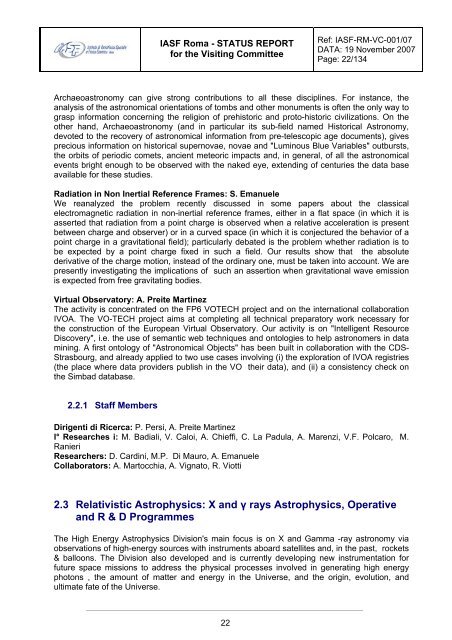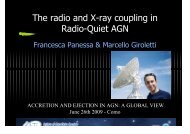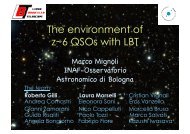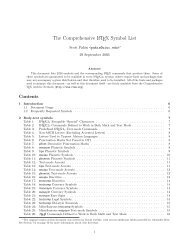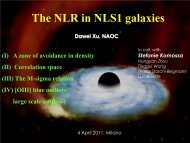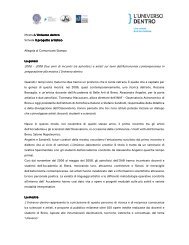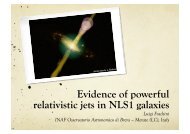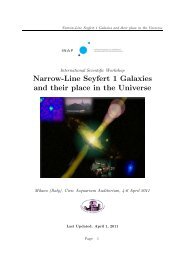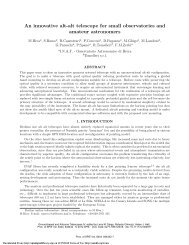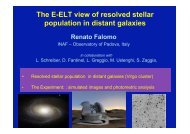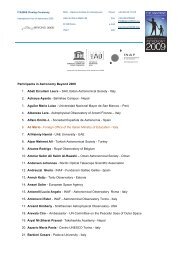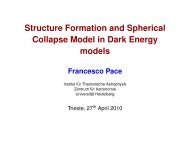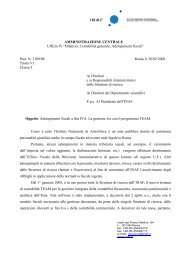<strong>IASF</strong> <strong>Roma</strong> - STATUS REPORTfor the Visiting CommitteeRef: <strong>IASF</strong>-RM-VC-001/07DATA: 19 November 2007Page: 22/134Archaeoastronomy can give strong contributions to all these disciplines. For instance, theanalysis of the astronomical orientations of tombs and other monuments is often the only way tograsp information concerning the religion of prehistoric and proto-historic civilizations. On theother hand, Archaeoastronomy (and in particular its sub-field named Historical Astronomy,devoted to the recovery of astronomical information from pre-telescopic age documents), givesprecious information on historical supernovae, novae and "Luminous Blue Variables" outbursts,the orbits of periodic comets, ancient meteoric impacts and, in general, of all the astronomicalevents bright enough to be observed with the naked eye, extending of centuries the data baseavailable for these studies.Radiation in Non Inertial Reference Frames: S. EmanueleWe reanalyzed the problem recently discussed in some papers about the classicalelectromagnetic radiation in non-inertial reference frames, either in a flat space (in which it isasserted that radiation from a point charge is observed when a relative acceleration is presentbetween charge and observer) or in a curved space (in which it is conjectured the behavior of apoint charge in a gravitational field); particularly debated is the problem whether radiation is tobe expected by a point charge fixed in such a field. Our results show that the absolutederivative of the charge motion, instead of the ordinary one, must be taken into account. We arepresently investigating the implications of such an assertion when gravitational wave emissionis expected from free gravitating bodies.Virtual Observatory: A. Preite MartinezThe activity is concentrated on the FP6 VOTECH project and on the international collaborationIVOA. The VO-TECH project aims at completing all technical preparatory work necessary forthe construction of the European Virtual Observatory. Our activity is on "Intelligent ResourceDiscovery", i.e. the use of semantic web techniques and ontologies to help astronomers in datamining. A first ontology of "Astronomical Objects" has been built in collaboration with the CDS-Strasbourg, and already applied to two use cases involving (i) the exploration of IVOA registries(the place where data providers publish in the VO their data), and (ii) a consistency check onthe Simbad database.2.2.1 Staff MembersDirigenti di Ricerca: P. Persi, A. Preite MartinezI° Researches i: M. Badiali, V. Caloi, A. Chieffi, C. La Padula, A. Marenzi, V.F. Polcaro, M.RanieriResearchers: D. Cardini, M.P. Di Mauro, A. EmanueleCollaborators: A. Martocchia, A. Vignato, R. Viotti2.3 Relativistic Astrophysics: X and γ rays Astrophysics, Operativeand R & D ProgrammesThe High Energy Astrophysics Division's main focus is on X and Gamma -ray astronomy viaobservations of high-energy sources with instruments aboard satellites and, in the past, rockets& balloons. The Division also developed and is currently developing new instrumentation forfuture space missions to address the physical processes involved in generating high energyphotons , the amount of matter and energy in the Universe, and the origin, evolution, andultimate fate of the Universe.22
<strong>IASF</strong> <strong>Roma</strong> - STATUS REPORTfor the Visiting CommitteeRef: <strong>IASF</strong>-RM-VC-001/07DATA: 19 November 2007Page: 23/134Recent Events: AGILE Assembly, Integration and Tests, Calibration, Launch,Commissioning and AO release; INTEGRAL Mission support, routine calibrations &response matrices deliveries, Core Programme and Open Time data analysis andscientific results; XMM & CHANDRA observation proposals and analysis; ESA CosmicVision proposals; Italian Space Agency (ASI) calls for Mission Opportunities, SmallSatellite & Technological Studies, <strong>INAF</strong> and MUR PRIN.X-ray astronomy has a short history, but has made rapid progress in the last 40 years. TheInstitute has been involved in building detectors to be employed aboard rockets and balloon andusing collected data since the time of the result from the first X-ray astronomy satellite,UHURU. At the end of the ‘80ies we have been involved with Spectrum X-Г with an hard X-rayimager and a polarimeter. Needless to remind about the Institute contribution since thebeginning to the BeppoSAX Mission both in terms of hardware and different scientific topicspublications. The GRB team has been awarded with the Rossi Price. This outstanding activitystarted at the end of ’80 up to now. More recently we contributed to the INTEGRAL Missionmainly with the IBIS instrument (P.I. and P.I. team) and also with Jem-X in terms of Co-Is. Theteam, besides working on hot scientific topics such as BHC, and NS in binary systems, PWNs,SFXT and AGNs, is still working on routine calibrations, special events and on the softwareupdating release in collaboration with the IBIS consortium and ISDC.The long experience and the new personnel hired on contracts supported by ASI dedicatedgrants ,has guaranteed the Institute successful leadership to the first Italian High energy ”small”Mission: AGILE recently in orbit and just completing the Commissioning phase. Furthermore,we had a very active role with 2 proposals (EDGE and GRI) submitted for the ESA call forMission and more recently for theItalian Space Agency call for proposals for “Missionopportunities”, “Technological development” and “Small Mission”.The main theme in Astronomy covered by the Division are: What are the fundamentalphysical law of the Universe and How did the Universe originate and what is made of.R&D activityThe experimental activity at <strong>IASF</strong>-<strong>Roma</strong> (formerly LAS and later IAS) was mainly based onoriginal experimental set-up and thence originated from a relevant effort of R&D. This was neverself-justified and more oriented to pursuit scientific goals in X-ray and Gamma-rayAstrophysics, although not all R&D achievements could arrive to an actual experiment.In early times the performance and preparation of rocket experiments pushed the developmentof position sensitive proportional counters for soft X-rays (0.1 – 3 keV) and some pioneeringwork on X-ray optics. When the experimental activity turned to stratospheric balloons, IASdeveloped large area pressurized proportional counters and, in parallel, position sensitiveproportional counters to be combine with coded masks. This was mainly driven from the intereston the study of extreme non thermal objects and to the need of identifying a survey technique inthe hard X-ray range. The know how of the coded mask technique came out very effective tocontribute to WFC of SAX and to exploit their data and to the design, realization and exploitationof INTEGRAL. Another R&D activity was oriented to X-ray polarimetry, first based on scatteringtechnique, subsequently focussed on the more performing photoelectric technique: this isnowadays one of the most promising development at <strong>IASF</strong>. Another major investment of theinstitute in R&D activities is on the domain of pixelled high Z semiconductor detectors, to becombined with coded masks or diffraction lenses, aimed to break the sensitivity wall in the HardX/ Soft Gamma-ray domain. More recently the interest to cosmologic applications of X-rayAstronomy has driven an engagement on the development of cryogenic detectors: in particularthose based on superconductors at the transition edge.23


